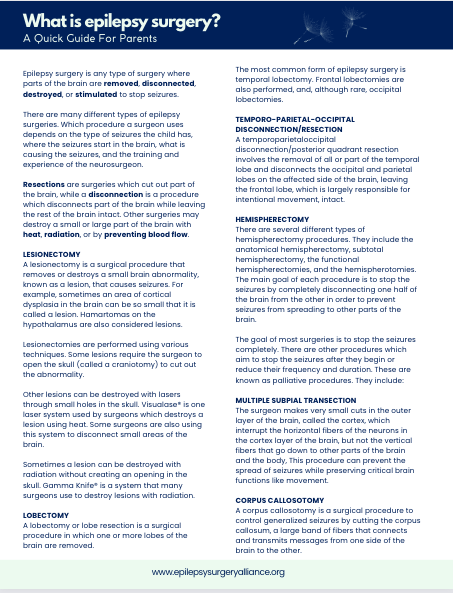What you need to know
What is epilepsy surgery?
Surgery for epilepsy is when the surgeon removes, disconnects, ablates, or stimulates a part of the brain to stop or slow down seizures.
There are many different types of epilepsy surgeries. They can be performed alone or combined.
Resection
Surgeries that remove part of the brain where the seizures start. Surgeons will use different types of techniques for this surgery, depending on how much of the brain is involved.
Disconnection
Surgeries that disconnect brain fibers such as corpus callosotomy or hemispherotomy. This stops seizures from traveling from where the seizures start to the rest of the brain.
Ablation
Surgeries that destroy the parts of the brain where seizures start. The most common surgery is laser ablation.
Neurostimulation
These are surgeries that stimulate a part of the brain to slow down or stop the seizures with special devices. These devices are sometimes called neuromodulation. The surgeon will implant a special device in the skull, neck, or chest. The device stimulates the brain with very low electrical currents.
Minimally invasive surgery
Some surgeries are minimally invasive. Minimally invasive surgeries limit the amount and types of openings in the skull to get to the brain. Many studies show that children recover faster after easier after these surgeries. These surgeries are usually performed with an endoscope or laser through a small opening in the skull.
Many children are candidates for minimally invasive epilepsy surgeries. Minimally invasive technique can be used to:
- Remove part of the brain
- Disconnect part of the brain
- Remove lesions or tumors
- Stimulate the brain.
Open surgery
In open surgery, the surgeon will make a large incision in the scalp and open part of the skull. The surgeon will then operate on the brain to remove or disconnect the areas causing seizures.
An open procedure may be the right surgery for your child. It’s important to discuss all your child’s options before making a decision.
Curative v. palliative surgery
All epilepsy surgeries are either curative or palliative.
Curative surgery is to stop your child’s seizures completely.
Palliative surgeries reduce the number of seizures your child is having. Usually, these surgeries will not stop seizures completely.
Your child’s surgeon will discuss the chances of seizure control with you. Whether the surgery stops the seizures depends on many reasons such as cause of the seizures, how long the child has been having seizures, and whether other parts of the brain are developing normally.
Curative surgeries
- Laser ablation
- Lesionectomy
- Lobectomy
- Hemispheric surgeries
- Amygdalohippocampectomy
- Hippocampal transection
- Posterior quadrant resection or disconnection (also known as temporoparietaloccipital disconnection or TPO)
- Radiofrequency ablation
- Stereotactic radiosurgery
- Interstitial radiosurgery
Palliative surgeries
Learn About The Epilepsy Surgeries
Watch this video with epilepsy surgeon Dr. Sandi Lam, Division Chief of Pediatric Neurosurgery at the Ann and Robert H. Lurie Children’s Hospital in Chicago. You’ll learn about the different types of epilepsy surgeries and why a surgeon may suggest one surgery over another.

